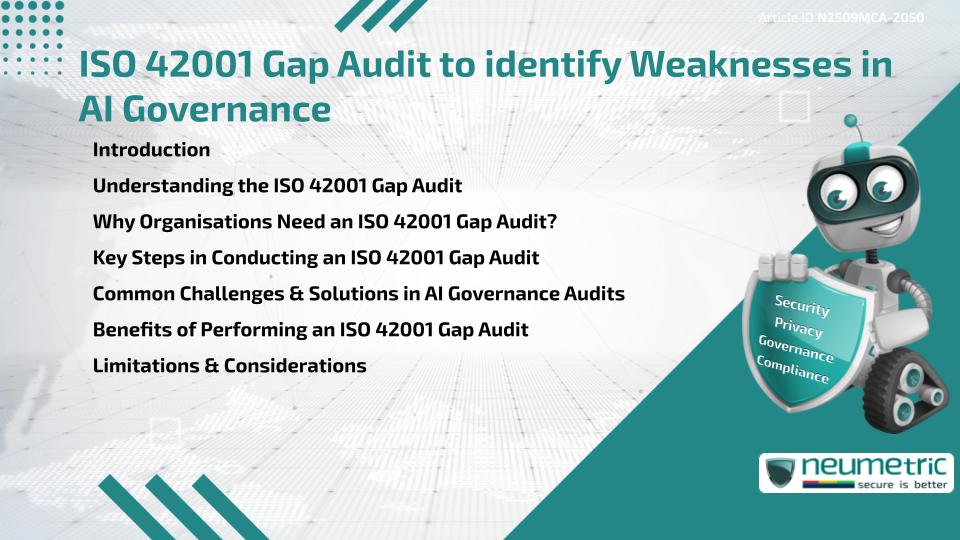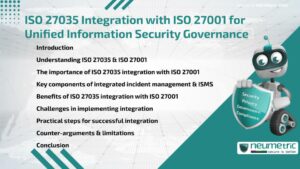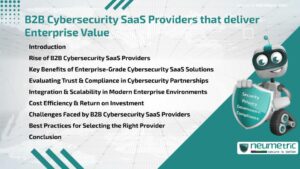Table of Contents
ToggleIntroduction
The ISO 42001 Gap Audit is a Structured review that helps Organisations identify shortcomings in their Artificial Intelligence [AI] Governance Practices. It provides a baseline for aligning with ISO 42001, the first International Standard for AI Management Systems. This Article explains the purpose, steps, challenges & benefits of conducting such an Audit to ensure responsible AI Deployment.
Understanding the ISO 42001 Gap Audit
An ISO 42001 Gap Audit evaluates an organisation’s existing AI Policies, Controls & Governance structures against the requirements of ISO 42001. The goal is to highlight Areas of Non-conformance & Suggest Actions to close those Gaps.
By doing so, Organisations gain clarity on what is needed to achieve Compliance, build Stakeholder trust & improve Accountability in AI Decision-making. For reference, see ISO.org.
Why Organisations Need an ISO 42001 Gap Audit?
AI Systems raise Unique Challenges such as Bias, Transparency & Accountability. Without Structured Oversight, Organisations Risk Reputational Damage, Regulatory Scrutiny & Ethical concerns.
The ISO 42001 Gap Audit helps by:
- Identifying Weaknesses in AI Governance Frameworks.
- Clarifying the path to Certification Readiness.
- Supporting responsible AI Development aligned with Ethical Standards.
- Demonstrating Accountability to Clients & Regulators.
The OECD AI principles reinforce the need for Global Trust-based AI Practices.
Key Steps in Conducting an ISO 42001 Gap Audit
- Scoping – Define the AI Systems, Processes & Departments to be reviewed.
- Document Review – Examine Policies, Governance Frameworks & Technical Documentation.
- Interviews & Assessments – Engage Stakeholders to evaluate Awareness & Practices.
- Gap Analysis – Compare current Practices with ISO 42001 requirements.
- Recommendations – Provide a Roadmap for Corrective Actions & Improvements.
- Follow-Up – Monitor Progress & Reassess Gaps as Systems evolve.
For implementation models, see NIST AI Risk Management Framework.
Common Challenges & Solutions in AI Governance Audits
- Complex AI Ecosystems – Break Audits into manageable Phases.
- Lack of Awareness – Provide Staff Training on ISO 42001 Principles.
- Evolving Regulations – Regularly update Audit criteria to reflect Legal changes.
- Resource Constraints – Use external expertise to support Internal Teams.
The NCSC UK AI guidance highlights similar Governance challenges in emerging Technologies.
Benefits of Performing an ISO 42001 Gap Audit
- Readiness for Certification – Provides a clear Roadmap to achieving ISO 42001 Compliance.
- Risk Reduction – Identifies Vulnerabilities & Governance Gaps early.
- Trust Building – Demonstrates proactive responsibility in managing AI Systems.
- Continuous Improvement – Establishes a Cycle of monitoring & updating AI Governance.
Limitations & Considerations
While an ISO 42001 Gap Audit offers valuable insights, it is not a One-time fix. AI Governance must evolve with new Risks, Technologies & Regulations. Additionally, the Audit is only as effective as the Commitment of Leadership & Staff to implement changes.
Takeaways
- An ISO 42001 Gap Audit identifies Weaknesses in AI Governance Practices.
- It involves Scoping, Document review, Assessments & Corrective Planning.
- Organisations benefit from improved Trust, Readiness & Risk Management.
FAQ
What is an ISO 42001 Gap Audit?
It is a Review Process that evaluates current AI Governance against ISO 42001 requirements.
Why should Organisations conduct it?
To identify Weaknesses, Reduce Risks & Prepare for ISO 42001 Certification.
Does the Audit guarantee Certification?
No, but it provides a Roadmap to help achieve Certification Readiness.
Who should be involved in the Gap Audit?
Stakeholders from Governance, Compliance, Data Science & IT Teams.
How often should it be conducted?
Annually or Whenever Major changes are made to AI Systems or Policies.
References
- ISO.org – International Standards
- OECD – AI Principles
- NIST – AI Risk Management Framework
- NCSC UK – AI Security Guidance
- ISACA – Emerging Technology Governance
Need help for Security, Privacy, Governance & VAPT?
Neumetric provides Organisations the necessary help to achieve their Cybersecurity, Compliance, Governance, Privacy, Certifications & Pentesting needs.
Organisations & Businesses, specifically those which provide SaaS & AI Solutions in the Fintech, BFSI & other regulated sectors, usually need a Cybersecurity Partner for meeting & maintaining the ongoing Security & Privacy needs & requirements of their Enterprise Clients & Privacy conscious Customers.
SOC 2, ISO 27001, ISO 42001, NIST, HIPAA, HECVAT, EU GDPR are some of the Frameworks that are served by Fusion – a SaaS, multimodular, multitenant, centralised, automated, Cybersecurity & Compliance Management system.
Neumetric also provides Expert Services for technical security which covers VAPT for Web Applications, APIs, iOS & Android Mobile Apps, Security Testing for AWS & other Cloud Environments & Cloud Infrastructure & other similar scopes.
Reach out to us by Email or filling out the Contact Form…





